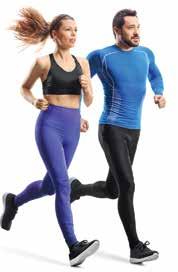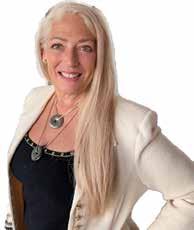PEOPLE. PLANET. PURPOSE.


HEALTHY LIVING | HEALTHY P LANET FREE APRIL 2023 GREATER LANSING
Publishers John & Trina Voell III
Assistant to the Publishers Carolyn Coogan
Design & Production John & Trina Voell III
Editor Martin Miron
Proofreader Randy Kambic
Calendar Theresa Archer
Sales & Marketing John & Trina Voell III


Distribution Kathy Matteo John & Trina Voell III
Website Design Locable
Website & Social Media SherTech
CONTACT US
734-757-7929
Publisher@HealthyLivingMichigan.com HealthyLivingMichigan.com
P.O. Box 2717, Ann Arbor, MI 48106
NATIONAL TEAM
CEO Kimberly B. Whittle
National Editor Sandra Yeyati
Editor Brooke Goode
Copy Editor/Proofreader Melanie Rankin
Design & Production
National Advertising

Gabrielle W-Perillo
Lisa Doyle-Mitchell
Natural Awakenings Publishing Corporation

350 Main Street, Suite 9B Bedminster, NJ 07921
Ph: 239-206-2000
NaturalAwakenings@KnoWEwell.com
© 2023 by Natural Awakenings. All rights reserved. Although some parts of this publication may be reproduced and reprinted, we require that prior permission be obtained in writing.
Natural Awakenings is a free publication distributed locally and is supported by our advertisers. Please call to find a location near you or if you would like copies placed at your business.
We do not necessarily endorse the views expressed in the articles and advertisements, nor are we responsible for the products and services advertised. Check with a healthcare professional regarding the appropriate use of any treatment.
Natural Awakenings is printed on recycled newsprint with soy-based ink.

Honoring the Earth
Happy Earth month, dear readers! Spring is unfolding, and we’re witnessing nature transforming itself into an exquisite, yet untamed beauty, inspiring a sense of excitement and optimism as the planet is reawakening and bursting with activity. Spring is my favorite time of the year because it always gives me a profound sense of rediscovery, exhilaration and hope. Hearing so many birds singing and frogs croaking fills my heart with immense peace and joy. I am excited just to be able to kick my shoes off and run around outside barefooted, feeling the earth between my toes.
This takes me back to my youth, as I watched my beloved grandpa tending to his fruit trees and gardens. Some of my fondest childhood memories include frolicking barefoot and playing care-freely while he tended to budding flowers and sprouting vegetables. I remember his warm, bright smile when I served him a beautifully decorated, helicopter-winged mud pie, too! His love and appreciation for nature gifted me, in turn, with a similar affinity, as well as a passion to preserve and honor Mother Earth.
As we celebrate Earth Day on April 22, people all over the world are showing a rising concern for the environment and what is happening to the land, rivers, lakes and air. It is time to think beyond our own local homes and towns to find ways to contribute to the continued health of our entire planet, because it’s all connected. Earth-friendly, sustainable living starts from the ground up, beginning with each of us. There is congruence between our own well-being and the way everyday lifestyle changes affect that. We must remember too, that health is a mindset of hope. To live life fully, it is important to make constant tweaks to our routine and seek consistent improvement for ourselves and all other beings.
Because everyone is at a different place along the continuum of health and wellness, there is always an opportunity to learn more. From the start, we’ve felt that Natural Awakenings’ intention is to empower people with information. It is our mission to positively impact and improve the quality of your whole family’s health by bringing you together with local resources of education and inspiration.
Our local vision aligns with that of our parent company to lead as a role model in the industry, to support healthy living both through our content and the way we do business. To that end, we are committed to consistently using 90 to 100 percent post-consumer recycled paper in the magazine, along with soy-based ink and, equally important, printing only on uncoated stock. When you know the facts about the way we all pay for the needless environmental destruction and waste resulting from the use of old-school glossy technology, going green is the obvious choice.
Since the birth of our magazine, we have received an abundance of support from many directions, and for that, we are forever grateful. As publishers, we truly delight in sharing Natural Awakenings with our growing healthy living community. We send our heartfelt thanks out to every reader, advertiser, contribution and distributor.
We hope you will think of our advertisers and distributors when seeking sources for your path to healthier living. Our small planet needs us, and we need each other. By making careful, conscious decisions, each of us, one by one, can make a real difference—at home, in our communities and around the world.
This month, take a moment to enjoy and appreciate all that nature continually provides to us.
Plant your thoughts and see your ideas blossom and unfold!
Be Well and Shine,
2 Greater Lansing HealthyLivingMichigan.com HEALTHY LIVING HEALTHY PLANET GREATER
EDITION letter from the publishers Natural Awakenings Magazine is ranked 5th Nationally in CISION’S 2016 Top 10 Health & Fitness Magazines
LANSING
Natural Awakenings is your guide to a healthier, more balanced life. In each issue you’ll find cutting-edge information on natural health, nutrition, fitness, personal growth, green living, creative expression and the products and services that support a healthy lifestyle.
10 THE EARTH AS MUSE
Inspiration Meets Conservation
12 A NEW DAWN ON THE FARM FRONT
Stepping Away From Industrialized Agriculture

15 JEFF MOYER on Farming for Human and Planetary Health

16 SUSTAINABLE EATING
Tips to Shrink Your Foodprint
19 KID-APPROVED AUTISM DIETS
Strategies to Optimize Nutrition and Acceptance

20 TOXIC OVERLOAD
How to Clean Our Water, Food and Indoor Air

22 THE WINDS OF CHANGE
Young Activists Pursue Climate Justice and Green Living
16
20
ADVERTISING
HOW TO ADVERTISE
& SUBMISSIONS
To advertise with Natural Awakenings, please contact us at 734-757-7929 or email Publisher@HealthyLiving Michigan.com. Deadline for ads: the 12th of the month.
EDITORIAL SUBMISSIONS
Email articles, news items and ideas to: Publisher@ HealthyLivingMichigan.com Deadline for editorial: the 12th of the month.
CALENDAR SUBMISSIONS
Submit Calendar Events at: HealthyLiving Michigan.com. Deadline for calendar: the 12th of the month.
REGIONAL MARKETS
Advertise your products or services in multiple markets!
Natural Awakenings Publishing Corp. is a growing franchised family of locally owned magazines serving communities since 1994. To place your ad in other markets call 239-434-9392. For franchising opportunities call 239-530-1377 or visit NaturalAwakenings.com
24 OUTDOOR SAFETY FOR PETS
3 April 2023
15 12
Contents
Navigate Hazards
Helpful Tips to
DEPARTMENTS 4 news briefs 8 health briefs 10 inspiration 11 therapy spotlight 15 wise words 16 conscious eating 19 healthy kids 20 healing ways 22 green living 24 natural pet 29 calendar 30 resource guide
GROW YOUR BUSINESS
Secure this ad spot!
734-757-7929
Energy Security at a Fair and Affordable Price

The ownership of Chelsea Plank Flooring, a Michigan-based hardwood flooring manufacturer, has recently embarked on a new venture they have named Great Lakes Applied Power. Starting as a small solar project to power an off-grid pole barn, Great Lakes Applied Power now offers solar-powered systems, for off-grid structures, solar emergency power systems as well as solar-powered contractor trailers.
David Frame, the owner of Great Lakes Applied Power, says, “Our new alternative power systems solve issues with power outages, as well as applications where standard line power is either unavailable or impractical. It’s nice to stay warm and to keep your frozen foods frozen when you lose power!” He explains, “By adding a battery bank to a solar or gas generator backup power system, the lights stay on when the sun goes down or your generator will only run a fraction of the time. This also allows homeowners to purchase a smaller, less expensive gas generator and save 60 to 80 percent in fuel usage.”
Shortly, Great Lakes Applied Power plans to add a hybrid system to their product offerings that will also reduce the amount of energy needed from the utility company.
Location: 740 W. Industrial Dr., Chelsea. For more information, call 734-897-0550. See ad page 30.
Women’s Wellness Series in May

This May, join Natural Awakenings and KnoWEwell for any of five women’s wellness events entitled Overcoming Stress: How to Balance It All. Each Tuesday at 8 p.m. EDT, top integrative and functional medicine experts in women’s health will present cutting-edge insights into the many ways that stress can impact hormones, thyroid function, fertility and libido, and also provide tangible recommendations to improve skin care, aging, sleep and mindset. The speakers are:
n Anna Cabeca, board-certified obstetrician and gynecologist, author of The Hormone Fix


n Trevor Cates, naturopathic doctor, author of Clean Skin From Within
n Arti Chandra, MD, MPH, family practice physician who earned her Certification in Functional Medicine as a member of the first class of practitioners to receive this designation from The Institute for Functional Medicine
n Anne Marie Fine, naturopathic doctor, author of Cracking the Beauty Code








4 Greater Lansing HealthyLivingMichigan.com
news briefs
n Carrie Jones, functional medicine physician specializing in hormone and thyroid health





































n Jaquel Patterson, naturopathic physician, success coach, author of Women and Lyme
n Carol A. Penn, board-certified physician, mindset coach, author of Meditation in a Time of Madness


















n Jaclyn Smeaton, naturopathic doctor specializing in hormone health and reproductive medicine





n Kela Smith, holistic-integrative fertility and hormone doctor




n Jyl Steinbeck, personal trainer and lifestyle expert
The $59 event fee includes all Tuesday evening sessions. To learn more and register, scan the QR Code on the inside back cover ad.

Harton House Reopening April 7






Harton House and Farms will reopen April 7 after making repairs due to vandalism at the greenhouse. They grow all their plants in state-certified organic soil. Owners Jeremy and Kathryn Harton think that self-sustainability means growing our own healthy vegetable plants knowing that no chemicals were used, saying,
“We grow each plant as natural as possible, fertilizing with Dairy Doo brand fertilizer, seaweed extract, kelp, fish emulsion and worm castings. All edible plants are non-GMO, heirloom seeds. The soil, seeds, fertilizer and worm castings are available to purchase onsite.”


Location: 3401 W. Bellevue Hwy., Olivet, between Charlotte and Marshall. For more information, visit HartonHouseAndFarm.com. See ad page 13.








Acupuncture Therapy at Solara Wellness




Solara Wellness offers acupuncture as a non-verbal form of therapy. They specialize in treating the root cause of women’s health conditions, infertility, migraine headaches, chronic pain, stress and anxiety. They offer a wide range of integrative therapies such as naturopathic medicine, massage therapy, craniosacral, reflexology, reiki and light therapy, all of

5 April 2023
BetterHealthMarket.com50% OFF EVERYTHING FROM OUR BEST FIVE BRANDS MONDAY APRIL 10TH THRU FRIDAY APRIL 14TH FIVE DAYS Save in all our 14 Michigan locations & online @ betterhealthmarket.com
Molly Sweet
Wellness and Retreat Center in Hallandale, Florida

If you have arthritis, diabetes, kidney problem, fatty liver, psoriasis, Obesity, Low immune system, Anxiety Our center is right place for you!
7•10•14 DAY ALL-INCLUSIVE HOLISTIC PACKAGES
Holistic Package includes:
n Comfortable rooms near the ocean
n Low carb diet food (lunch, dinner)
n Oxygen cocktail, Green cocktail
n Yoga classes
n 4 treatments a day
n Transportation From airport
We work with each individual to find the right treatment. We are with you every step of the way as you improve your health!
Treatments we are offering:
• Ionic detox
• Lymph drainage
• Cupping massage
• Reflexology massage
• Hot stone massage
• Classical massage
• Infrared wrap with collagen and Dead Sea application
Call
which can be quite beneficial for those struggling with stress, anxiety and trauma.
“Naturopathic medicine involves the use of natural remedies and therapies to support the body’s innate healing abilities, while massage therapy can help to soothe tense muscles and promote relaxation,” advises owner and founder Molly Sweet, LAc. “Adopting a holistic approach to health care is one of the cornerstones of Solara Wellness.” They believe in treating the whole person, rather than just symptoms, because this approach promotes optimal health and well-being in the long run.
New acupuncture or naturopathic patients get 20 percent off supplements or herbal products with code “NATAWAKENINGS” at booking. Location: 644 Migaldi Lane, Ste. 300, Lansing. For appointments and more information, call 517-388-1507 or visit SolaraWellness.net.

Start a Juice Cleanse for Better Health at Juice Nation
Juice Nation, with locations in Lansing, East Lansing and Okemos, is offering a juice cleanse. A one-day cleanse ($57) includes six juices; a three-day cleanse ($175) includes 18 juices; a five-day cleanse ($280) includes 30 juices; and a seven-day cleanse ($375) includes 42 juices. A cleanse helps break bad food habits such as eating out of boredom or eating too much junk food. It gives us the opportunity to start fresh and reset the body.

Tameko Richard and husband Vernon Richard sell 100 percent organic cold press juices, smoothies, smoothie bowls and more. They say, “We use all whole fruits; no sugars, no syrups. We only use honey to sweeten, and we use deionized ice so you’re getting all-natural products that are much healthier for you. You don’t have to have a huge meal, and you can get full off the smoothie. It’s like a meal replacement.”
Locations: 111 S. Washington Square, Lansing; 2830 E. Grand River Ave., East Lansing; and 3520 Okemos Rd., Ste. 1, Okemos. For orders and more information, call 517-372-7700 or visit JuiceNationMI.com.
• Electromagnetic therapy
• Jade application
• Ultrasonic cavitation
• Lipo laser treatment
• Vitamin IV
• Much more
WellnessAndDetoxcCenter.com
Enjoy Walk-In Pet Care at Soldan’s Soldan’s

Pet Supplies and VIP Petcare will conduct VIP Pet Clinics from 1 to 2:30 p.m., April 1, 15 and 29, at their South Lansing location, and from 10 to 11:30 a.m., April 1 and 29, at their West Lansing location. Services include microchipping, vaccinations, RX flea and tick control, heartworm prevention and testing and deworming.
Microchips for dogs and cats, especially those that roam outdoors, help owners reunite with their stray pet when taken to an animal shelter or veterinary clinic. De-worming services are essential for removing disease-causing parasites in domestic animals. Fleas and ticks can also cause illnesses and diseases in humans and pets, which is why it is important to take prevention seriously. Vaccines take just minutes to administer, but can protect a pet from dangerous diseases for up to a year. Veterinarians strongly recommend pets receive heartworm prevention medication year-round because heartworm disease is a serious ailment.
6 Greater Lansing HealthyLivingMichigan.com news briefs
us today:
305-916-1248
No appointment is necessary. South Lansing location: 55200 S. Martin Luther King Jr. Blvd., 517-882-1611; West Lansing location: 6201 W. Saginaw Hwy. 517-323-6920; also locations in Okemos, Dewitt, Charlotte, Midland, Mount Pleasant and Bay City. For more information, email Info@SoldansPet.com or visit SoldansPet.com/events.
Unique Cranial-Facial Balancing Therapy at Williamston Wellness
Williamston Wellness


Chiro Spa is now offering Cranial-Facial Balancing with owner Simone Ranes, DC. This technique will increase circulation to the head and improve the physical alignment of the jaw,
cranium and neck, as well as normalize cranial pressure imbalances resulting from birth trauma, concussion, traumatic brain injury, whiplash injury and sinus conditions.
Common symptoms that may improve with cranial adjustment include headaches, TMJ pain, vertigo/balance issues, tinnitus and sinus pain. If the presenting symptoms are severe or traumatic in nature, the patient may be referred for concurrent medical care and advanced imaging of the head and neck. The bones of the skull determine the shape and function of the brain. We need cranial balance to keep the function of brain well, but certain injuries to the skull can cause the bones to be knocked out of their proper alignment.
Cranial facial release is often done with other chiropractic treatments. It is a specialized treatment and there are very few doctors that perform it. She also offers chiropractic, massage therapy, facials and yoga.
Cost is $100 per hour. Location: 1235 E. Grand River Rd., Ste. 1A, Williamston. For appointments and more information, call 517-6554234, email WilliamstonWellness@gmail.com or visit Williamston Wellness.com.
7 April 2023
De-Stress With Sauerkraut

A new study published in Molecular Psychiatry has shown that eating more fermented foods and fiber daily for just four weeks significantly lowered perceived stress levels. Forty-five participants with relatively low-fiber diets were split into two groups.
One group met with a dietitian that recommended a psychobiotic diet, which included six to eight daily servings of fruits and vegetables high in prebiotic fibers, such as onions, leeks, cabbage, apples, bananas and oats; five to eight daily servings of grains; three to four servings of legumes per week; and two to three daily servings of fermented foods like sauerkraut, kefir and kombucha. The control group received only general dietary advice based on the healthy eating food pyramid.

The group following the psychobiotic diet reported feeling less stressed compared with those in the control group. Moreover, significant changes in the level of certain key chemicals produced by gut microbes were found in these participants. Some of these chemicals have been linked to improved mental health, which could explain why the participants reported feeling less stressed. The quality of sleep improved in both groups, but those on the psychobiotic diet reported greater sleep improvements.
Screening Children for Anxiety


After a systematic review of 39 studies to evaluate the benefits and harms of screening for anxiety disorders in children and adolescents aged 8 to 18, the U.S. Preventive Services Task Force (USPSTF), a group of disease prevention and medical experts assembled by the U.S. Department of Health and Human Services, now recommends that primary care physicians perform such screenings, even if there are no signs or symptoms of anxiety.
A common mental health condition in the U.S., anxiety disorder involves excessive fear or worry that manifests as emotional and physical symptoms. In children and adolescents, it is associated with impaired functioning, educational underachievement and an increased likelihood of a future anxiety disorder or depression. The 2018-2019 National Survey of Children’s Health found that 7.8 percent of children and adolescents aged 3 to 17 had a current anxiety disorder.
USPSTF recommended using screening questionnaires to identify children at risk, noting that studies show that children with anxiety benefit from treatments that may include cognitive behavioral therapy or psychotherapy. They also concluded that there is insufficient evidence to assess children 7 years old or younger.
Exercise for the Brain
Researchers in the UK compared the effect that different types of daily movement had on overall cognition, memory and executive function. Their study, published in the Journal of Epidemiology andCommunityHealth, reported that replacing sitting, sleeping or gentle movement with less than 10 minutes of moderate to vigorous activity (brisk walking, bicycling, running up and down stairs, aerobic dancing, jogging, running or swimming) can protect the brain and improve working memory and executive processes like planning and organization. The intensity of the exercise matters, and study participants that engaged in light


8 Greater Lansing HealthyLivingMichigan.com If You Are Reading This, So Are Your Potential Customers. Text us today for special rates and start attracting more business! 734-757-7929 health briefs
physical activity, rather than more vigorous activity, saw declines in cognitive performance. However, light activity is still more beneficial than sitting, the scientists found.

The data for these findings was taken from the 1970 British Cohort Study, an ongoing survey that tracks the health of a group of UK-born adults. The group of nearly 4,500 participants consented, at age 46, to wear an activity tracker and complete verbal memory and executive functioning tests, and they were followed from 2016 to 2018.
Pomegranate May Offer Skin and Gut Benefits

Pomegranate fruit has been widely used in traditional medicine, and a new, randomized, double-blind, placebo-controlled study published in the Journal of Clinical Medicine looked at the effects of taking pomegranate extract for a period of four weeks on different aspects of skin and gut health. Using facial imaging, researchers found the group that received the pomegranate extract had significant reductions in wrinkle severity and a decrease in the rate of forehead sebum excretion. They also found beneficial effects to the gut-skin axis, noting that participants in the pomegranate extract group had a higher abundance of Eggerthellaceae in the gut with accompanying wrinkle reduction. The scientists concluded that the skin benefits from pomegranate extract may be due to the potent antioxidant and anti-inflammatory properties of phytochemicals, as pomegranate contains more than 100 bioactive constituents.
Possible Links Between Veggie Diets and Depression




Plant-based diets have been associated with several health benefits, but not much is known about their effects on mental health. A new Brazilian study published in the Journal of Affective Disorders surveyed more than 14,000 people between the ages of 35 and 74 for a period of six months and found that those following a vegetarian diet were twice as likely to have a depressive episode than meat eaters, even when other lifestyle factors like smoking, alcohol consumption, physical activity and micronutrient intake were taken into account. The nature of this correlation between vegetarianism and depression is still unclear, and more research is needed.



9 April 2023
Relieve Pain, Decrease Inflammation, and Increase Healing. As seen on Commonly Treated Conditions: • Knee Pain • Shoulder Pain • Back Pain • Elbow Pain • Arthritis • And More! Ask about Our $49 New Patient Special—Call Today! (517) 381-1880 SoftWave Therapy – TRT OrthoGold 100 is an exciting, breakthrough option in the field of regenerative medicine. It is a non-invasive treatment that utilizes shockwaves to rapidly reduce chronic pain and greatly accelerated recovery with sustaining results. OKEMOS FAMILY CHIROPRACTIC GROW YOUR BUSINESS Special Ad Rates! Text us today. 734-757-7929
The Earth as Muse
INSPIRATION MEETS CONSERVATION
by Marlaina Donato
The Earth is both our mother and our muse, sustaining our lives and blessing us with beauty when we make time to notice her perpetual creative forces. She has long inspired expressive souls of all disciplines, but some of our modern innovators are merging talent with the urgent need to minimize toxic impact. This eco-vision has resulted in some awe-inspiring efforts.
In an awareness-based art installation he calls Ice Watch, Danish-Icelandic artist Olafur Eliasson collected 30 blocks of glacial ice found free-floating near Greenland and placed them in public settings across London where passersby could observe them melting.
Artists John Dahlsen and Rox De Luca spotlight the plastic waste catastrophe in their sculptures and paintings by using debris washed up on the shores of Australia’s beaches. Their sculptural assemblages hang from ceilings and criss-cross walls, driving home the prediction by the World Economic Forum that by 2050 our precious oceans will be more crowded with plastic than marine life.
When creating our own art, we can join these stirring visionaries by minimizing toxic impacts.

Buy Earth-friendly art supplies for the kids. The common crayon contains chemicals like formaldehyde and asbestos, which are harmful to humans and the planet. Opt for biodegradable glitter, non-toxic modeling clays and recycled paper. For more sustainable supply ideas, visit Tinyurl.com/EcoArtSupplies
Get creative with single-use trash items. Paper towel cardboard rolls, plastic shopping bags, bottles, straws and cutlery can be turned into fun projects for kids, teens and adults. Whimsical mobiles, sculptures and magical miniature cities are just a few ideas to conjure while contributing to Earth Day every day. For more ideas, visit Tinyurl.com/SingleUseTrashToArt
Inspire environmentalism by choosing art implements that celebrate nature. Consider using alternatives to toxic solvents, pigments and varnishes. Look for sustainable brushes made from bamboo or corn and easels fashioned from eucalyptus wood.
Marlaina Donato is a visionary painter who hosts art exhibits for community healing. She is also an author and composer. Connect at WildflowerLady.com.
10 Greater Lansing HealthyLivingMichigan.com
Secure your growing space! Contact us today. 734-757-7929
GROW YOUR BUSINESS
inspiration
Detail on Detroit's Deborah Hecht's "Something's Fishy"; DeborahHechtStudio.com/beach-trash
Getting to the Root of Chronic Anxiety with Emotional Complex Clearing
what the issues are. Used correctly, we can then generate a list of the past experiences that have caused or contributed to the present problem. This is the Target List.
For example, John complained of a constant tension in his chest, overwhelming anxiety, palpitations and frequent panic attacks. His Target List included:
From conception on, Mom and Dad fought constantly. John thought it was his fault.
John was a difficult breech birth. The (unconscious) decision he made was, “I’m not okay. I caused my mom pain.”
by Brad May Ph.D.
We could certainly argue that anxiety is simply part of the normal human experience. For instance, we have a presentation at work and there’s a lot at stake. It’s understandable to be anxious. But about those people whose anxiety never goes away or who have always been anxious, the psychiatrist may well say, “You have a chemical imbalance.”
We may say, “Well, my mother was anxious. It must be genetic.”
Although genetics are important, they are not destiny. These days, there is an equal or greater emphasis on the emerging science of epigenetics—the lifestyle choices and experiences that tend to shape us. If it is indeed a chemical imbalance, it's important to know where it came from. It actually may come from the unresolved past.
Muscle testing, or Kinesiology, can be used to access the relevant past experiences that have led to the present anxiety. Muscle testing has been around for about 60 years, primarily used by chiropractors. Psychotherapists have largely shied away from it, perhaps because it involves simply touching the client.
Muscle testing involves pushing down on the client’s outstretched arm while putting the other hand on their shoulder to steady them. The deltoid muscle will either hold strong, meaning the arm doesn’t move much at all, or go weak, meaning the arm comes down. (There are numerous examples on YouTube.)
If the muscle test is preceded by a question, we can use this curious phenomenon to get information from that deeper part of the client—whether we call it the unconscious, the inner self, or the higher self. These answers seem to bypass conscious filters and access a deeper truth, so what is revealed is not what they think or what the practitioner thinks, but what is really so.
With Emotional Complex Clearing, a strong response means true and a weak response means false. This is sort of like an internal lie detector, except this procedure is always used with a willing participant, not a suspect.
We can thus use muscle testing to determine at what age(s) past trauma or problematic events occurred and then identify
At age 3, John felt left out when his baby sister was born and she got more attention. The (unconscious) decision he made was, “I don’t matter.”
At age 9, he and a friend engaged in mutual masturbation and oral sex. He felt ashamed and dirty as a result.
At age 17, he was sexually inappropriate with an underage girl and arrested. He felt guilty and humiliated.


At age 19, his father died. They were very close, and John suppressed his grief. After using a clearing process over several sessions to resolve these issues, plus adding the support activity of letter-writing and group sharing, John said, “I don’t have the anxiety now, and the pressure around my heart is gone. I feel much better and I’m more at ease with myself. My emotions were all messed up, and I held them inside for so long. Working with you, there was no BS. I couldn’t lie. Now I feel like something came off my back.”
For about two years, John called this therapist on a regular basis and reported no recurrence of his previous problems.
For more information, including a free Zoom introduction to Brad May, Ph.D., and an upcoming seminar in Ann Arbor, visit ecctherapy.com. See ad page 20.
11 April 2023
therapy spotlight
Muscle Testing 1. The result of a STRONG response. The arm stays up.
Muscle Testing 2. The result of a WEAK response. The arm goes down.
A NEW DAWN ON THE FARM FRONT
STEPPING AWAY FROM INDUSTRIALIZED AGRICULTURE
 by Sandra Yeyati
by Sandra Yeyati
12 Greater Lansing HealthyLivingMichigan.com
We all have to eat, and the food industry is big business, with wide-ranging implications across many arenas. Because agriculture is controlled by a handful of multinational corporations, the priority to maximize profits often conflicts with what is best for human and planetary health. In many ways, our food production and consumption practices are broken or on the brink of failure. They are inhumane, socially unjust, environmentally unsound and unsustainable.
Viable, achievable solutions to these immense challenges exist, and the emerging consensus is that regenerative organic agriculture is the key to preserving human health and helping solve the climate crisis. The COVID-19 pandemic uncovered weaknesses in the system, such as supply chain vulnerabilities, and altered human behavior as more people started cooking at home and exploring healthier lifestyle choices. The time is right to make positive changes to the way we grow, distribute and consume food.
The Problems With Our Current Industrial Farming Model

For decades, doctors, scientists, farmers and nonprofits at the forefront of the environmental movement have been sounding the alarm about the inherent weaknesses in the national food chain and the harmful effects of industrial agriculture. In his book Food Fix: How to Save Our Health, Our Economy, Our Communities and Our Planet—One Bite at a Time, Dr. Mark Hyman notes, “Food is the nexus of most of our world’s health, economic, environmental, climate, social and even political crises. While this may seem like an exaggeration, it is not.”
In the late 1800s, American farming began to transition from small, diverse operations that produced a variety of crops and livestock to feed a family or community to an industrialized system dominated by multinational corporations that focused on maximizing yields of just a few crops, primarily corn, soy and wheat. Today, these crops overwhelmingly end up as animal feed, biofuels and cheap, processed food ingredients—a staple of the standard American diet since the 1950s.
Industrial agriculture is now the dominant food production system in this country, characterized by large-scale monoculture, heavy use of chemical fertilizers and pesticides, and meat
produced in confined animal feeding operations (CAFO). Most modest family farms have been forced to either get into business with a big company (contract farming) or go out of business. The Natural Resources Defense Council reports that 90 percent of the 9 billion chickens raised each year in the U.S. are grown under contract, and 57 percent of hogs are owned and slaughtered by just four companies. According to Rodale Institute, only 8 percent of farms produce more than four crops, while specialty crops like fruits, vegetables and nuts are grown on just 3 percent of cropland.
With industrial dominance comes numerous devastating consequences.
Human Health Costs
According to the Union of Concerned Scientists, industrially produced food is bad for us on several fronts. Heavy pesticide use is poisoning our food, fertilizer is polluting our drinking water, junk food made of corn and soybeans is degrading our health and the overuse of antibiotics in CAFOs is accelerating the development of antibiotic-resistant bacteria. Bioethicist Peter Singer advises, “Factory farms are breeding grounds for new viruses. We’ve had swine flu and avian flu coming out of factory farms. It’s quite possible that the next pandemic will originate there.”
Zach Bush, a triple board-certified physician and producer of the documentary Farmer ’s Footprint, says, “Over the last 25 years, we have seen the most profound explosion of chronic disease in human history. Research from around the globe now suggests that environmental factors are contributing to a combination of genetic, neurologic, autoimmune and metabolic injuries that underpin the collapse of health in our children and adults.”
The U.S. Centers for Disease Control and Prevention report that chronic and mental health conditions account for 90 percent of the nation’s $4.1 trillion in annual health care expenditures. Obesity affects 20 percent of children and 42 percent of adults. More than 850,000 Americans die of heart disease or stroke annually, and 37 million have diabetes. Each year, more than 1.7 million people are diagnosed with cancer, while 600,000 succumb to the disease.
“Most of those diseases are caused by our industrial diet,




13 April 2023
3401 W Bellevue HWY • Olivet • MI 49076 hartonhousefarm.com We Carry a Full Line of State Certified Organic Soil Full Stock of GMO Free Heirloom seeds Your Local Garden Center FIND US ON FACEBOOK! (269) 749-9664 Annuals, Vegetables & Hanging Baskets
which means they are avoidable if we transform the food we grow, the food we produce and the food we eat. Eleven million people die every year from a bad diet,” Hyman asserts.
Solutions Using Regenerative Organic Farming

Led by the Regenerative Organic Alliance, which includes organizations and brands like Rodale Institute, Dr. Bronner’s and Patagonia, the Regenerative Organic Certified (ROC) standard helps consumers make informed choices about their food purchases. Its three pillars—soil health, animal welfare and social fairness—are designed to ameliorate the problems associated with conventional agriculture.
Soil Health Equals Planetary and Human Health
Chemical-heavy farming practices employed by conventional agriculture deplete topsoil, draining it of all its organic matter—the very microbiome needed to nourish the plants we grow and ultimately nourish us. In 2014, Maria-Helena Semedo, of the United Nations Food and Agriculture Organization, said that if current farming practices continue, we have only 60 years of harvest left. The clock is ticking. Farming techniques proposed by the ROC are designed to continually rebuild soil. They are proven by years of science done at Rodale Institute and practical results achieved by regenerative organic farmers already growing food this way. “On the farm that we operate here at the Institute, we know that Native Americans were farming this land 8,000 to 10,000 years ago. We’d like to be farming this land 8,000 to 10,000 years from now. We probably won’t be using tractors or diesel fuel, but we will be using the soil,” says Rodale Institute CEO Jeff Moyer. Under ROC standards that include a variety of rotating crops, cover crops, no tillage, no synthetic inputs of any kind, no genet-
ically modified seeds and staggered grazing by animals, farms become biodiverse ecosystems with organically rich soil that absorbs water, doesn’t erode over time and produces safe, nutritious food. As J.I. Rodale said, “Healthy soil equals healthy food equals healthy people.”
Healthy soil draws carbon from the atmosphere deep into the ground, and that is a boost for our fight against climate change. “Regenerative organic farming has a very positive impact on climate, because we’re sequestering more carbon than we are emitting,” Moyer explains. “Under its current production model, agriculture is part of the problem. If it’s part of the problem, then it can and should be part of the solution. That’s the whole premise behind the [ROC] standard itself—treating agriculture as one of the primary tools that we’re going to use as a society to improve our relationship with the planet.”
Animal Welfare Is the Right Thing to Do
Under the ROC model, animals must be raised in a humane way that frees them from discomfort, fear, distress, hunger, pain, injury and disease, while also being able to express normal behavior. To achieve these aims, they need to be taken out of CAFOs and reintegrated into farmland, so that they are pasture-raised and grass-fed, creating meat that is more nutritious and less diseased without chemical interventions.
“We’re integrating animals onto the cropland, with livestock, chickens, sheep and hogs. Imagine what the Great Plains of the United States was 500 years ago. You had bison, elk, deer, rabbits, wolves and myriad different birds, because the birds always followed the migrating animals. We’re trying to mimic that to a small degree on our ranch,” says North Dakota farmer Gabe Brown, who started transitioning into regenerative organic practices in the mid-1990s and wrote an influential book on the subject, Dirt to Soil: One Family’s Journey into Regenerative Agriculture.
Social Fairness and Farming Resilience
Taking care of the farmers and workers that plant, raise, harvest and transport our food is not just the right thing to do, it also creates a system that is more stable and resilient, says Graham Christensen, a Nebraska farmer and president of GC Resolve. “There are serious issues with how the big agricultural companies are treating workers. We saw horrible situations with COVID in the meatpacking plants and how the workers were being treated. This is just one of the many reasons that this over-centralized, monopolized system is affecting people in bad ways,” he says. “Regenerative organic farming requires more hands-on work, which creates jobs. Structural changes in the food production system to decentralize agriculture in favor of regional markets comprised of smaller farms would allow for more equity and better management of the ecosystem.”
14 Greater Lansing HealthyLivingMichigan.com
Sandra Yeyati is national editor of Natural Awakenings magazine.
Jeff Moyer: on Farming for Human and Planetary Health
by Sandra Yeyati
Why is conventional agriculture problematic?
Because it boils down the measurement of farming success to one word: yield. By focusing just on yield and sacrificing long-term resource stability to get it, we’re chewing up topsoil at a national rate of fiveand-a-half tons per acre of farmland per year for short-term economic benefit. You can only do that so long before you run out of topsoil. It doesn’t make sense long-term.
What farming practices does Rodale Institute promote?

We’re suggesting a different production model, based on science, that incorporates other metrics of success: soil health and long-term planetary and human health. As a side bar, let’s say you’re a smoker and you stop smoking—your lungs will regenerate. The same is true with soil. If we change production practices, the soil will regenerate.
Under our Regenerative Organic Certified standard, we want well-thought-out crop rotations to get more biodiversity into the system, cover crops and reduced tillage to get more earthworms, and a reintegration of livestock into farms. I’m not going to argue whether people should be eating animals, but if you are going to have animals in the system, they should be raised on farms with grass, not feed lots with grain.
Why is soil health such a priority?
Healthy soil is more biologically active and has a positive impact on climate because it doesn’t just sequester more carbon, it sequesters it at greater depths. We want car-
bon to last in the soil for a very long period of time. We don’t want it to be short-cycled in and out of the system, and we want to sequester it at greater depths where we can control it and maintain it for hundreds of years. Ideally, we’ll get it deeper and deeper in the soil over time.
Can regenerative organic agriculture affordably feed the world?
Affordability is a strange term. Can we produce all the food we need at a reasonable cost? Absolutely. The problem with the conventional model is that we don’t pay the true cost of food production at the point of purchase. As an example, when we have to dredge the Mississippi River because of all the soil that’s washing into it from agricultural lands, you don’t pay that bill at the supermarket or restaurant. You pay it as a hidden cost, buried in our tax structure.
In an organic system, you’re paying the true cost of the production of that food at the point of purchase, which makes more sense. And if you add the cost of human
health—diabetes, heart disease—all the things that our current food production and food consumption model embodies, then the system we have now is outrageously expensive, and regenerative organic food is cheaper than conventional food.
Can regenerative organic agriculture produce the amount of food needed worldwide?
Yes. In most parts of the world, we use agricultural lands to produce all kinds of commodity products that aren’t food. Forty percent of the corn we produce in the U.S. goes to ethanol production and another 40 percent goes to livestock feed. The ink in your pen was made with soybean oil. If we decided to produce the most amount of food on an acre or hectare of land, we can produce way more food than we need.
What we’re saying is that conventional agriculture cannot feed the world longterm. In the short-term, we’re producing a lot of cheap food, but our current production model is doomed to failure over time because we’re going to run out of healthy soil to farm.
Are you hopeful about the future of agriculture?
Very hopeful. The USDA says that most organic farms are more profitable and expanding at a more rapid rate than their conventional counterparts, and that’s because we have a growing population of support in the marketplace. People are beginning to pay attention to how their food is produced, asking the right questions and recognizing that they have a vote with their food purchasing dollars. We’re seeing the concept of regenerative organic enter into the daily conversation, just like we did a few years ago with organic. People didn’t know what organic meant at first. Recent USDA statistics suggest that roughly 80 percent of the nation’s population has eaten something organic in the last 30 days, so people are seeking out organic, and we’re going to follow the same course with regenerative organic.
15 April 2023
wise words
Sandra Yeyati is national editor of Natural Awakenings magazine.
SUSTAINABLE EATING
TIPS TO SHRINK YOUR FOODPRINT
 by Ana Reisdorf, MS, RD
by Ana Reisdorf, MS, RD
Knowing which foods have the least environmental impact is not always easy. Organic blueberries are considered Earth-protective because no pesticides were used to grow them, but if they were shipped from California to a Florida grocery store, the transportation represents a steep carbon footprint. And if we waited too long to eat those blueberries and had to throw them away, all of the resources spent on producing those fruits were wasted.
16 Greater Lansing HealthyLivingMichigan.com conscious eating
Studio/ShutterStock.com
Look
To get a fuller picture of our food-related environmental impacts, we need to take into consideration the many variables associated with the production, transportation and consumption of food, and that’s where the “foodprint” comes in—a barometer of eco-friendliness. There are many ways to calculate a foodprint; EarthDay.org/foodprints-calculators lists a few automated calculators and food quizzes that can help. Here are noteworthy examples:
n EatLowCarbon.org compares the carbon emissions associated with different meals—ranging from bean soup (lowest CO2 emissions) to a Philly cheesesteak (highest).
n FoodPrint.org offers a questionnaire about a person’s food choices and follows up with tips to reduce their foodprint.
n FoodEmissions.com calculates the foodprint of specific foods like dairy or seafood by asking about the origination and destination of the food to determine transportation emissions, and by asking the consumer to self-report their percentage of waste to calculate the loss of natural resources.
How to Reduce Our Foodprint
BUY RESPONSIBLY PRODUCED FOOD
When shopping for groceries, consider buying from food producers that support environmental stewardship, sustainability and regenerative farming practices in their production systems. A list of third-party certifications that can help identify responsibly manufactured foodstuffs can be found at Foodprint.org/eating-sustainably/food-label-guide
BUY LOCAL AND IN SEASON
Lisa Andrews, MEd, RD, owner of Sound Bites Nutrition, encourages her clients to eat local, seasonal produce. “[It] spares the environment, as it doesn’t need to be flown across the country, reducing fuel costs,” she explains, adding that local produce is generally more nutritious and cost effective.
STORE FOOD CORRECTLY
According to the U.S. Department of Agriculture (USDA), 30 to 40 percent of the available food supply is wasted. While there are many reasons for food loss at all stages of production and deliv-
ery, consumers can have a major impact in reducing how much food is wasted.
The U.S. Environmental Protection Agency provides advice for properly storing foods in the refrigerator: leafy veggies go in the high-humidity drawer, while most fruits should be placed in the low-humidity bin. Some fruits like apples and avocados release ethylene gas and can cause nearby produce to spoil, so they should be stored separately. Wash berries just before eating them to prevent mold. Store potatoes, onion and garlic in a cool, dry, dark and well-ventilated place. Freeze bread, meat or leftovers that won’t be eaten before they spoil.
CONSUME SUSTAINABLE FOODS
According to Registered Dietitian Lauren Panoff, one way that consumers can benefit the environment is by transitioning to a more plant-predominant lifestyle. “Plant foods utilize far fewer natural resources than industrial animal agriculture, which is also one of the largest emitters of greenhouse gases and drivers of Amazon deforestation,” Panoff explains.
Patricia Kolesa, MS, RDN, founder of the Dietitian Dish, notes, “Plant-based proteins tend to be more affordable and can be stored longer than your animal proteins, helping reduce food waste.”

Nutritics, a food information company, offers a list of the highest-ranking foods when it comes to sustainability, considering inputs like water usage, carbon emissions or capture, land usage and nitrogen storage capabilities. Their list includes mussels, beans, lentils, peas and other legumes, mushrooms, seaweed, cereals and grains, and organic fruits and vegetables.
RESPONSIBLY DISPOSE OF OR SHARE UNEATEN FOOD
Perfectly fresh food that the family has decided not to eat can be donated to people in need. Visit FoodPantries.org to find a nearby soup kitchen or food bank. Compost scraps and spoiled items to divert them from landfills. For composting instructions by the USDA, visit Tinyurl.com/USDAcompost.
Ana Reisdorf is a registered dietitian and freelance writer with more than 15 years of experience in the fields of nutrition and dietetics.
17 April 2023
Igisheva Maria/ShutterStock.com
conscious eating
UNWRAPPED EGG ROLL NOODLES
YIELD: 6 SERVINGS
1 rotisserie chicken, shredded
1 cup green cabbage, finely shredded
1 cup purple cabbage, finely shredded
½ cup carrot, finely shredded
¼ onion, sliced
½ cup peanut butter
3 Tbsp coconut aminos
2 Tbsp sesame oil
1 tsp garlic
Salt to taste
Konjac noodles (optional)
Sesame seeds
In a skillet, heat one tablespoon of sesame oil. Add the sliced onions and cook until softened. Add shredded chicken, cabbage, carrot, coconut aminos, remaining sesame oil, garlic and salt to taste. Once the cabbage has wilted and cooked, add the

SUSHI BITES

YIELD: 10 SERVINGS
1½ cups cooked sushi rice, cooled
3 sheets nori paper
SALMON OR MUSSELS
1 lb boneless, skinless wild-caught sockeye salmon, cubed (can substitute with mussels)
2 Tbsp sesame oil
1 Tbsp honey or maple syrup
½ tsp garlic powder
2 Tbsp coconut amino teriyaki sauce
Salt to taste
SPICY MAYO
¼ cup avocado mayo
2 tsp sriracha sauce
1 tsp coconut aminos
TOPPINGS
½ avocado, diced small
2 tsp black sesame seeds
Preheat oven to 350° F. Cook rice according to package instructions and set aside to cool. Mix spicy mayo ingredients and set
peanut butter. Mix in noodles.
Serve hot, sprinkled with sesame seeds. For a vegan or vegetarian alternative, omit the chicken.
Used with permission of Madiha M. Saeed, M.D.
aside. Mix salmon ingredients and set aside. Cut each nori sheet into four equal squares. Line a muffin pan with unbleached muffin liners. To each nori square, add about 1 tablespoon of rice and top with the salmon mixture. Transfer the filled squares to the muffin pan. Bake 15 to 17 minutes for salmon or 7 to 10 minutes for mussels. Allow the sushi bites to cool slightly and top with avocado, sesame seeds and a drizzle of spicy mayo.
Used with permission of Madiha M.
18 Greater Lansing HealthyLivingMichigan.com
Saeed, M.D.
Kid-Approved Autism Diets
Strategies to Optimize Nutrition and Acceptance
by Ana Reisdorf, MS, RD
Autism Spectrum Disorder (ASD) is characterized by challenges with social interaction and communication. For parents of children with autism, learning to manage this condition requires a multidimensional approach, including consideration of food and nutrition. A personalized, nutritious diet can help manage behavioral problems, health risks and quality of life for kids with autism.
Beth Lambert, executive director of Epidemic Answers, says, “Once you come to understand autism as a whole-body condition, rather than just a brain-based or genetic condition, you start to understand the importance of nutrition in treatment and symptom management.” Not only does a nutritious diet help maintain brain balance, it also helps address many of the nutrition-related concerns that children with autism face, such as food sensitivities and allergies, digestive disruptions, sensory issues with textures and nutrient deficiencies. Each of these issues can impact a child’s behavior.
An essential piece of the autism and diet connection is gut health.
Gaby McPherson, MS, RDN, LDN, at Fruitful Nutrition, says, “Because a child’s gut health is linked to their brain health, it’s crucial to boost their gut function to reduce these symptoms that can impact their behaviors. Who wants to go around with a tummy ache and constipation every day?”
Yaffi Lvova, RDN, author of Beyond a Bite: Playful Sensory Food
Exploration for ASD and Neurodivergent Kids, advises that individual abilities also should be considered when developing a nutrition plan. “Autistic children often have sensory sensitivities that make it difficult to eat certain (sometimes many) foods,” she says.
Therapeutic Diets. Many therapeutic diets have been evaluated for children with autism. Most involve the elimination of one or more foods, which can be challenging for a child that already has difficulty getting a wide variety of nutrients.

A popular option is the gluten- and casein-free diet. Gluten is the protein found in wheat, barley and rye. Casein is a protein found in milk and other dairy products. While some children with autism may be sensitive to gluten or dairy, this is not a one-size-fits-all approach, and there is mixed data in support of this regimen.
Another choice is the specific carbohydrate diet (SCD), which involves limiting certain carbohydrates, processed foods, most dairy, sugar and more, with the goal of reducing food sensitivities and improving the gut microbiome. Mixed outcomes have been reported with this diet due in part to its elimination of high-fiber foods that may be beneficial for brain health. McPherson explains, “Gut bacteria digest (or ferment) fiber in the large intestines to produce short-chain fatty acids, which are known to improve brain health significantly.”
The Feingold diet is another approach that eliminates artificial flavors, sweeteners, preservatives and salicylates. Salicylates are compounds found in certain fruits and vegetables. While there is some evidence that food dyes may play a role in children’s behavior, most studies on this diet have not demonstrated a significant impact on ASD symptoms.
Personalized Nutrition.
Instead of following a specific therapeutic diet, most experts now understand that a diet for ASD needs to be personalized to each child. It is ideal to work with a registered dietitian that can address nutrient and feeding concerns and is trained to make individualized recommendations. A primary area to focus on, according to Lambert, is correcting vitamin deficiencies, which may play a role in improving behavioral and digestive challenges. Nutrients of concern include zinc, vitamin D, calcium, magnesium and essential fatty acids. McPherson also relates that fiber should be at the forefront of any diet to address digestive concerns. “While many children on the spectrum may strongly prefer foods like chips, crackers, bread or white pastas, these foods tend to be lacking in fiber,” she says. “Good sources of fiber are split peas, multigrain breads and pears.”
A registered dietitian can also help families evaluate whether a diet is working. Lvova says, “It can be challenging to see whether a specific diet is working or not. When a change is made, the parents and caregivers often pay more attention in order to see if there is a difference, and the child responds positively to the change in attention. By keeping expectations realistic and ensuring a relaxed mealtime atmosphere, your child will have the best chance to meet their nutritional needs.” Ultimately, the goal is to make meals a positive experience for the child, with less emotional investment on which foods they can or cannot eat.
Ana Reisdorf is a registered dietitian and freelance writer with more than 15 years of experience in the fields of nutrition and dietetics.
19 April 2023
healthy kids
Toxic Overload
How to Clean Our Water, Food and Indoor Air
 by Madiha M. Saeed, M.D.
by Madiha M. Saeed, M.D.

oxins are in the water we drink, the food we eat and the air we breathe. The U.S. Environmental Protection Agency (EPA) Chemical Substances Control Inventory shows the magnitude of our potential exposure, listing more than 86,000 industrial chemicals that are manufactured or processed in this country. Despite regulations and safety protocols, a number of these dangerous compounds run off into waterways or are released
into the atmosphere. Food manufacturers use some of them to preserve or beautify their products.
“We live in an increasingly toxic world, and the best defense against becoming overwhelmed by toxins is limiting what we take in as much as possible,” emphasizes Paul Anderson, an integrative and naturopathic clinician and co-author of Outside the Box Cancer Therapies. While our bodies are not designed to handle the accumulation of industrial chemicals, pesticides, pharmaceuticals and radiation that seep into our personal space, we can take measures to reduce the assault and protect our health.
Filter Drinking Water
“For the health-conscious individual, toxins in the water is the top threat often overlooked or inadequately addressed,” says Rajka Milanovic Galbraith, an Illinois-based functional medicine practitioner, noting that drinking water is packed with chemicals like per- and polyfluorinated alkyl substances (also known as forever chemicals), solvents, pesticides, metals, bleach and radiological contaminants such as uranium and cesium. These substances can cause cancer, reproductive health concerns, and kidney and liver problems.
T“I have treated hundreds of patients who have restored their health and are already eating and living clean by properly filtering their water, but sometimes, even when using a very expensive water filtration system, people will still find high levels of contaminants like MTBE [methyl tertiary-butyl ether], an additive in unleaded gasoline that is banned in several states,” Galbraith says. “Reverse osmosis typically filters most hazardous chemicals from your water, but they can be pricier. An inexpensive alternative are the filters from Clearly Filtered, which reportedly remove 99 percent of MTBE, among many other chemicals.”
“Everyone should try to filter their water with any means available, from a carbon block pitcher to the most aggressive method using a reverse osmosis water filter under their sink. Given the state of municipal—and well—water and the amount we need to

20 Greater Lansing HealthyLivingMichigan.com GET THE RESULTS OF LONG-TERM THERAPY IN JUST A FEW HOURS! Tired of Dealing with Anxiety and/or Depression? Or Just Stuck? You’ve tried Everything, but your Emotional/Mental issues prevent you from Embracing Life? Ready to Root Out the Causes of your Challenges and Clear them up? EMOTIONAL COMPLEX CLEARING GAIN FREEDOM FROM THE PAST WITH For more information and to register: ecctherapy.com Presenter: Brad May, Ph.D. A licensed therapist for more than four decades and author of FEELING GOOD ABOUT FEELING BAD and MUSCLE TESTING MIRACLES Professor coast to coast at 11 Universities. “Emotional Complex Clearing” FREE Introduction via Zoom on May 24, 2023 at 7:30PM | Watch replay at ecctherapy.com SEMINAR: June 23, 2023 7PM-9:30PM | June 24 & 25, 9:30AM-5:30PM | Ann Arbor, Michigan | $345 if Paid by May 25th | $375 after May 25th healing ways
clean our bodies and brains every day over a lifetime, we need to get this right,” advises Aly Cohen, M.D., an integrative rheumatologist, founder of The Smart Human and co-author of Non-Toxic: Guide to Living Healthy in a Chemical World







Read Food Labels

“For the individual newer on their health journey, I would say food additives are the ‘hidden’ environmental exposure that is a serious cause for concern, contributing to autoimmune diseases and from a metabolic standpoint, think weight gain, obesity, pre-diabetes and diabetes,” Galbraith says. “These additives are used to increase palatability, shelf life and texture and can include some you may have heard of, like sucralose, citrate and carrageenan, and others you may not have, like carboxymethylcellulose and polysorbate-80. Carrageenan is common in many nondairy milk alternatives that have made their way into coffee shops.”
According to Galbraith, the most effective way to steer clear of food additives is to avoid or greatly minimize the consumption of highly processed foods. She recommends eating whole foods, especially for those dealing with chronic health issues or experiencing signs or symptoms of an ailment. She also encourages people to read food labels and avoid products with artificial colors, carrageenan, butylated hydroxytoluene (BHT), monosodium glutamate (MSG), nitrates and nitrites, polysorbate 80, propyl gallate, propylparaben, methylparaben, sodium benzoate, potassium benzoate, tert-Butylhydroquinone (TBHQ) and titanium dioxide.
“You are what you eat!” Cohen exclaims. “Eating clean food, without synthetic chemicals that break down the protective microbiome of the gut, is critical to the health of our immune system and our mental health, so we should try to eat whole, unprocessed foods that are USDA [U.S. Department of Agriculture] Certified Organic whenever possible.”
Improve Indoor Air
According to the EPA, “Americans, on average, spend approximately 90 percent of their time indoors, where the concentrations of some pollutants are often two to five times higher than typical outdoor concentrations.” The Environmental Working Group offers a comprehensive blueprint at ewg.org/healthyhomeguide that identifies dangerous chemicals found indoors (from lead, asbestos and flame retardants to volatile organic compounds, antimicrobial agents and radon) and recommends actions to clean up our sanctuaries.
“We can lower our toxic burden by decreasing the chemicals in the air that we breathe, and that begins by reducing the junk we bring into our homes,” Cohen remarks. “Start by removing air fresheners, perfumes, bug sprays, scented cleaning and laundry products, and by opening the windows daily, adding lots of plants and possibly adding an air filter for those who live in cities and areas with poor air quality.”
at &


 Madiha Saeed is a holistic, functional and integrative doctor in Naperville, Illinois, and director of education for Documenting Hope and KnoWEwell.
Madiha Saeed is a holistic, functional and integrative doctor in Naperville, Illinois, and director of education for Documenting Hope and KnoWEwell.
THE WINDS OF CHANGE
YOUNG ACTIVISTS PURSUE CLIMATE JUSTICE AND GREEN LIVING
 by Sheila Julson
by Sheila Julson
Born in the mid-to-late 1990s up to the early 2010s, Generation Z environmental activists agree that urgent action is needed to achieve climate justice, and they’re willing to do what it takes to get results. “Climate and environmental justice and environmental racism are very big concerns among youth, whether or not they are youth of color. It’s not just about energy, water or air—it’s also very much about people,” says Ana Garcia-Doyle, executive director of One Earth Collective. The Chicago nonprofit inspires action, facilitates learning and promotes environmental justice through annual programs like the One Earth Film Festival and One Earth Youth Voices, a summit designed to give voice to the next generation’s environmental concerns.
Chalmers credits One Earth with helping her connect with people that normally would not be involved with climate activism. Her peers share in the understanding that there’s a climate crisis. “The Earth is breaking,” she explains. “We need to fix it. Everybody needs to do a better job of taking action.” Getting people to pay attention is challenging, Chalmers laments, especially given America’s overwhelming dependence on automobiles and the lack of public transportation. “A lot of people want to help, but just don’t know how,” she notes. “Some people don’t have the financial ability to make environmentally sound choices.”
Teens Take Charge.
Marin Chalmers, a sophomore at Oak Park River Forest High School, in Illinois, and member of One Earth’s Youth Advisory Council, has been participating in the One Earth Young Filmmakers contest since the seventh grade. Her short documentary, Sondaica, is about wildlife and ecosystems.
Although individual action can help mitigate climate change, 16-year-old Sebastian Delgado, a Revolutionary Youth Action League (ROYAL) volunteer, blames polluting, profit-driven corporations for the climate crisis. “The biggest threat to our climate and people of color is capitalism,” he explains. “We need a new economic system that’s not based on profit.”
ROYAL volunteers like Delgado collaborated with Marlene BritoMillán, Ph.D., an ecology assistant professor at Loyola University
22 Greater Lansing HealthyLivingMichigan.com green living
Chicago, and Dr. Bryan Ramson, a nuclear physicist and research associate at Fermilab, to craft a social justice plan that incorporates climate town hall meetings to raise awareness and develop action plans.
According to Delgado, even when concerned citizens contact their elected representatives, leaders can be slow to act. “Climate change has been happening for decades, and we’re still dealing with the same issues,” he remarks, adding that bold ideas and unwavering action are needed when government officials won’t listen to their constituents.
Greening Urban Areas. In Austin, a predominantly Black neighborhood on the west side of Chicago, two 20-year-olds, Cortez Dean and Ethan Horne, work at paid internships in an urban farming program called Austin Grown, which raises chickens and maintains gardens with vegetables and native pollinators.
A collaboration between One Earth Collective and BUILD Chicago, a nationally respected youth development organization, Austin Grown serves urban communities where fruits and vegetables are hard to find. The organization also offers gardening and healthy eating classes to the public.
Dean is learning firsthand how climate change adversely affects farms, gardens and forests where food and medicinal plants are grown. During a summer heat wave, he witnessed a sewer pipe explode, filling his neighborhood with a powerful stench, and he worries that aging infrastructure will contaminate their drinking water.
“People assume there’s time to solve climate change, but we’re not slowing things down. There’s a lot of work to be done,” Horne says, noting that food deserts disproportionately affect communities of
color. “There are lots of areas with no grocery stores, or stores that only offer chips and candy, but no fruits and vegetables.”
Dean and Horne concur that gardening provides needed green infrastructure and nutritional food to underserved populations. “I didn’t fully understand climate change until I put my hands into the soil. When you do that, you’ll see Earth for what it is—and the damage we’ve done to it,” Dean says.

Activism on University Campuses.
Originally from Waukesha County, Wisconsin, 21-year-old Grace Arnold feels lucky to have attended two schools with strong environmental programs and student engagement. At the University of Vermont, she participated in marches against fossil fuels and joined lively discussions about climate-related racism at the Social Justice Coalition. Now a student at University of Texas at Austin, she is enrolled in environmental studies classes and notes, “Students are forming environmental clubs. I’m grateful to again be surrounded by people trying to get their voices heard.”
Arnold was a social media volunteer for Plastic-Free MKE, a Milwaukee-based organization dedicated to reducing single-use plastic waste. She credits social media as a powerful tool that helps her generation reach people and organize activism. “Climate change is intertwined with social, economic and political issues,” she relates. “But small actions can make big impacts—and voting is a powerful thing.”
23 April 2023 oatawaAdobeStock.com
Sheila Julson is a freelance writer and contributor to Natural Awakenings magazine.
Helpful Tips to Navigate Hazards
Choose non-chemical lawn management methods that are safe for pets, like neem oil or diatomaceous earth.
 by Paige Cerulli
by Paige Cerulli
With nicer spring weather, pets will likely spend more time outside. Whether lounging in the backyard, taking a walk around the neighborhood or venturing out to a dog park, our awareness of potential dangers is important. Despite the risks, there is no reason to keep pets cooped
up. With diligence, protecting our furry best friends can become second nature as we safely enjoy the great outdoors together with our pets.

Home and Yard. A fenced yard might seem like a safe space for pets, but that is not always the case. “Pesticides, herbicides and

24 Greater Lansing HealthyLivingMichigan.com n Acupuncture n Herbal Medicine n Spinal Manipulation 10444 W Grand River Hwy, Grand Ledge, MI 48837 (517) 412-7171 Compassion4PawsHealing.com Integrative, healing modalities we offer Include: Integrative Medicine, Holistic Wellness, Rehabilitation Therapy for Your Pet. Injuries and illnesses that we treat include: n Nutritional Consultation n Osteopathic Manual Therapy n Essential Oils n Aromatherapy n Food Therapy n Healing Touch n Arthritis n Allergies n Digestive Issues n Behavioral Issues n Geriatric Disorders n Coughing or Sneezing n Urinary Tract Issues n Skin or Nail Issues n Lumps or Bumps
natural pet OUTDOOR SAFETY
FOR PETS
fertilizers are just a few of the toxic substances that could be in a pet owner’s yard,” explains veterinarian Alex Schechter, of Burrwood Veterinary, in Royal Oak, Michigan. “These substances can harm dogs and cats if they are consumed or come into contact with a pet’s skin.”
A 2013 study published in Environmental Research found that dogs exposed to professionally applied lawn care pesticides had a 70 percent higher risk of developing canine malignant lymphoma than dogs that were not exposed to these products.
Schechter recommends that pet owners choose non-chemical lawn management methods that are safe for pets, like neem oil or diatomaceous earth. “Reduce the use of chemicals by using organic farming practices or natural fertilizers,” he says.
Veterinarian Dwight Alleyne, an advisor at Betterpet, cautions that a yard might be home to plants that are poisonous to pets. “Some of these plants could include lilies, sago palms, tulips and oleander,” he advises. “It is important for pet owners who have a backyard to be able to identify any potential hazards before leaving their pet out unattended.”
Neighbors’ Yards. According to the U.S. Environmental Protection Agency, mouse or rat poison is a popular pest control choice that kills by causing excessive bleeding. Use of this product can be extremely dangerous to pets if they ingest either a poisoned rodent or the poison itself. Schechter warns, “If you see bait stations or dead rats, those areas may have been treated with a rodenticide.” He advises pet owners to have a conversation with their neighbors, suggesting the use of snap or electronic traps as more humane and less toxic alternatives.
Driveways. Coal tar sealants used on driveways contain polycyclic aromatic hydrocarbons (PAH) that, according to the U.S. Centers for Disease Control and Prevention, may pass through skin or be inhaled. In large amounts, PAHs can irritate eyes and breathing, and several PAHs are carcinogenic in humans. Avoid sealing driveways with any coal tar products. When out for walks, pet owners should keep their dogs off other driveways, as well.
Outdoor Excursions. Dog parks carry several risks, including exposure to intestinal parasites. A 2020 study found that 85 percent of the 288 dog parks sampled had at least one dog infected with gastrointestinal parasites like Giardia, hookworms, whipworms or roundworms. These parasites can be transmitted when dogs eat or sniff poop.

“It is recommended that your dog is on a monthly heartworm preventative, which can help protect against common parasites that they may encounter,” says Alleyne. If a dog regularly visits dog parks, a vet can perform a fecal exam to identify and treat any intestinal parasites that the dog may have contracted.
When visiting ponds and lakes, beware of blue-green algae bacteria, which commonly proliferate in freshwater bodies, particularly during summer months. Dogs can ingest algae by playing in or drinking the water, or when licking their paws. In large quantities, algae can be toxic to dogs (and humans). Because algae are not always visible, keeping dogs leashed around bodies of fresh water is best.
Paige Cerulli is a freelance writer in Western Massachusetts specializing in the health and care of pets.




25 April 2023 Call (231) 714-0477 for a FREE phone consult or home survey Do you have new unexplained Health Effects? We uncover Wireless risks that may be affecting your Health! Sources of Harmful Wireless Radiaton: Most affected are organs: Skin, Eyes, Lungs, Brain, Heart, Thyroid, Stomach Symptoms You May Have: Pets are also affected by extreme new levels. Most common Symptoms: Digestion & Skin issues – for related info see EMFinvestigator.com/pets Itching/burning skin, Digestive upset, Breathing distress, Headaches, Nerve pain, Tinnitus, Trembling,,Brain fog, Agitation, Blood Sugar & Hormonal imbalance 4G/5G Cell Towers/Antennas; small cell nodes, repeaters, Smart Meters; electric, gas & water, Cell/cordless phones, WiFi, Bluetooth, Computers & Smart devices. Make your Home environment healthier today. Visit EMFInvestigator.com to learn more


Greater Lansing HealthyLivingMichigan.com




28 Greater Lansing HealthyLivingMichigan.com
calendar of events
SATURDAY, APRIL 1
VIP Pet Clinics – Apr 1 & 29, W Lansing: 1011:30am. Apr 1, 15, 29, S Lansing: 1-2:30pm. Services include microchipping, vaccinations, RX flea and tick control, heartworm prevention and testing and deworming. Microchips for dogs and cats. Soldan’s Pet Supplies, 55200 S Martin Luther King Jr Blvd, S Lansing; 6201 W Saginaw Hwy, W Lansing. SoldansPet.com/events.
SUNDAY, APRIL 2
Groove Your Heart Out Fitness – 7-8pm. Sarah Stein creates an inviting and safe space that allows you the opportunity to explore the unlimited possibilities of movement, range of motion and expression in your body to foster self-awareness, authentic movement, creativity and unique self-expression. LiveWELL: The Healing Community, 2820 Covington Crt, Lansing. GoLiveWell.org.
MONDAY, APRIL 3
Meditation Monday – 7-8:30pm. A unique blend of short-technique “helper lessons” that improve your meditation practice combined with a guided meditation with a silent portion (semi-guided). $10/ class. Davison Holistic Therapies, 921 North State Rd, Gathering Room, Davison. Register: Tinyurl. com/2pp8fwnh.
WEDNESDAY, APRIL 5
Capital City Film Festival – Apr 5-15. Showcases an eclectic mix of independent films, live music, interactive media and more. Held at several venues across Lansing. CapitalCityFilmFest.com.
THURSDAY, APRIL 6
Virtual Easter-Themed Cooking Demo – 7-8pm. Luna and Nate are professional chefs who run the vegan food blog Cooking Up Vegan. They will be demoing their vegan deviled eggs and vegan lox. Register: VegMichigan.org.
Full Pink Moon Vibrational Healing Circle –7-8:30pm. Bring your drum, rattles, singing bowls, anything that creates a vibration and join us for a healing circle full of spirit. $15. Davison Holistic Therapies, 921 North State Rd, Gathering Room, Davison. Register: Tinyurl.com/mr2s38yf.
FRIDAY, APRIL 7
Groove Your Heart Out Fitness – 10-11am. See Apr 2 listing. LiveWELL: The Healing Community, 2820 Covington Crt, Lansing. GoLiveWell.org.

SATURDAY, APRIL 15
Joyful Spirit – 4-5pm. Created through a blend of meditation, energy healing and expansion and freeform dance and movement, this workshop will raise your vibrational level and make your spirit sing. $20. Davison Holistic Therapies, 921 North State Rd, Gathering Room, Davison. Register: Tinyurl. com/2s3bmhus.
MONDAY, APRIL 17
Meditation Monday – 7-8:30pm. See Apr 3 listing. Davison Holistic Therapies, 921 North State Rd, Gathering Room, Davison. Register: Tinyurl. com/2pp8fwnh.
SATURDAY, APRIL 22
Earth Day BioBlitz Exploration – 9am-12pm. Enjoy a thrilling journey of discovery and join a community of citizen scientists for a guided walk along the River Trail. No prior experience necessary; experienced guides will provide all the training needed. Potter Park Zoo, 1301 S Pennsylvania Ave, Lansing. 517-483-4222. PotterParkZoo.org.
Fenner Conservancy Earth Day Extravaganza – 9am-3pm. Volunteers may select a conservation or stewardship activity like picking up trail trash, pulling invasive species and maintaining trails or participate in a larger project like updating the Playscape and working in the pollinator garden. 2020 E Mt Hope Ave, Lansing. Fill out form: MyNatureCenter.org/earth-day-extravaganza.
ongoing events
sundays
Sunday Happy Hour – 4:20-5pm. Receive 20% off the entire order. Edgewood Cannabis, 134 E Edgewood Blvd, Lansing. 517-580-7078. Edge woodCannabis.com.
\ mondays
Medible Mondays – 10am-7pm. Enjoy 10% off all edibles. Edgewood Cannabis, 134 E Edgewood Blvd, Lansing. 517-580-7078. Edgewood Cannabis.com.
Meridian Township Earth Day Stewardship and Pizza Party – 9:30am-3pm. A special Earth Day invasive species removal followed by a pizza party and native seed sowing. Harris Nature Center, 3998 Van Atta Rd, Okemos. Must preregister: 517-853-4614 or ecampbell@meridian.mi.us. Meridian.mi.us.
Mushroom Grow Course – 12-3pm. Learn everything you need to know to get started. The Seed Cellar, 1620 E Michigan Ave, Jackson. More info: Tinyurl.com/yc7ck79f.
THURSDAY, APRIL 27
Harton House and Farms Reopens – After making repairs due to vandalism at the greenhouse. They grow all their plants in state-certified organic soil. All edible plants are non-GMO, heirloom seeds. The soil, seeds and worm castings are available to purchase onsite. 3401 W Bellevue Hwy, Olivet, between Charlotte and Marshall. HartonHouse AndFarm.com.
PLAN AHEAD
SATURDAYS, MAY 6
Wisdom & Wellness Fair – 11am-6pm. A great stop-over during the M-15 Garage Sale. Healings, shopping and lots to see and do. Free admission.
tuesdays
Terpy Tuesdays at The Jade Collection – 9am9pm. Selected for potency, flavor, terpene profile and distinguished genetic heritage. Special deals. 1098 E Main St, Morenci. 517-458-3009. Weed maps.com/dispensaries/jade-collection.
Hypnotherapy with Cheryl Beshada, C.M.Ht. –9:30am-7pm, by appt. Also Weds. Cheryl teaches and specializes in personal empowerment, releasing blocks and patterns of negative behavior, higher self-communication. Free consultation. Warren. 586-899-9009.
Terpy Tuesdays – 10am-7pm. Take 10% off fullpriced concentrates and vape cartridges. Edgewood Cannabis, 134 E Edgewood Blvd, Lansing. 517-5807078. EdgewoodCannabis.com.
wednesdays
Wake ‘n’ Bake Wednesdays – Orders placed between 10am-12pm receive 10% off the entire order. Edgewood Cannabis, 134 E Edgewood Blvd, Lansing. 517-580-7078. Edgewood Cannabis.com.
Allen Farmers Market – 3-6:30pm. Year-round. Stock up on groceries and visit the Eastside Lan-
29 April 2023
Davison Holistic Therapies, 921 North State Rd, Gathering Room, Davison. Register: Tinyurl. com/3566k86u.
ongoing events
sing Food Co-Op onsite at the same time. 1629 E Kalamazoo St, Lansing. Facebook.com/AllenFarmersMarket.
thursdays
Top Shelf Thursdays – 10am-7pm. Rotating top shelf brands are on sale. Edgewood Cannabis, 134 E Edgewood Blvd, Lansing. 517-580-7078. Edge woodCannabis.com.
Stitch In – 5-7pm. Join us with knitting, crochet, spinning, weaving, embroidery, hand sewing, macrame, or whatever else your hands are working on. An inclusive all-ages group, embracing those new to their craft through to life-long practitioners. Woven Art Yarn Shop, 325B Grove St, East Lansing. 517-203-4467. WovenArtShop.com.
fridays
Freebie Fridays – 10am-7pm. Spend $100 or more and receive a pre-roll for a penny. Edgewood Cannabis, 134 E Edgewood Blvd, Lansing. 517-5807078. EdgewoodCannabis.com.
saturdays
Online: Self-Love Focused, Live-Chat-Session with Oracle Card Pulls – 9-10am. Set time aside for you to chat with like-minded people and receive messages of inspiration from the divine as well as motivation to move forward from Coach Sherry. Free. TikTok.com/@find_ ur_happy.
Certified Hypnotherapists Education and Networking Meeting – 9:30am-12pm. 1st Sat. Certified Hypnotherapists welcome. Includes educational presentation, workbook and digital material. Clinical Hypnosis Professional Group, Warren. Register: 586-899-9009.
Showcase Saturdays – 10am-7pm. Featuring specials on a rotating basis. Edgewood Cannabis, 134 E Edgewood Blvd, Lansing. 517-580-7078. EdgewoodCannabis.com.
community resource guide
ALTERNATIVE POWER SOLUTIONS
GREAT LAKES APPLIED POWER

740 W. Industrial Drive, Chelsea 734-897-0550
GreatLakesAppliedPower.com

We are devoted to third-generation ultra-efficient power solutions using the latest technology and advanced product design. Please contact us for more information or for assistance selecting a Power Cell or Solar Power Wagon to fit your needs!
BRAIN GYM
THE AHA CENTER FOR AWAKENING HEALTHY AWARENESS
Opal Wong, M.A. Educ. 4111 Okemos Rd., Ste.#102, Okemos


Peak performance through designed movement. Brain Gym equips people—kids, adults and seniors alike—with the designed movement techniques to reach goals they never imagined possible. Opal is available by appoinment only. Appointments can be made in person at her office Tuesday through Thursday, 12-4:30pm.
HYPNOSIS
CLINICAL HYPNOSIS INSTITUTE
Cheryl Beshada, C.M.Ht.

8200 Old Thirteen Mile Rd., Ste 110, Warren 586-899-9009
ClinicalHypnosisInstitute.com
Become a Certified Hypnotherapist. Saturday and Sunday classes begin June 10 in-person and/or on-line. State-licensed School—Ongoing Support. Private Sessions Available.
INTEGRATIVE / HOLISTIC WELLNESS FOR PETS
COMPASSION 4 PAWS
VETERINARY HEALING CENTER
517-412-7171
10444 W Grand River Hwy, Grand Ledge Compassion4PawsHealing.com

Offering a wide array of holistic services, including acupuncture, herbal medicine & food therapy. Arthritis, allergies, digestive issues, and behavioral issues, are just a few examples of conditions that benefit greatly from holistic therapies. See ad page 24.
SCHOOL / EDUCATION
NATUROPATHIC INSTITUTE OF THERAPIES & EDUCATION
503 East Broadway St, Mt. Pleasant 989-773-1714
Contact@NaturopathicInstitute.info
NaturopathicInstitute.info

Educational programs offered: Natural Health Program: four years (one weekend a month); Massage Therapy Program: one year (two weekends a month); Holistic Doula Practitioner Program: six months (one weekend a month). Individual classes available. See ad page 7.
SOLID HARDWOOD PLANK FLOORING

CHELSEA PLANK FLOORING
740 W. Industrial Drive, Chelsea 734-433-1023
ChelseaPlank.com
Natural. Beautiful. Versatile. Longevity. Green. In simplest terms, a solid plank of hardwood flooring is a piece of a tree. It is neither laminated, extruded, mixed nor reconstructed from industrial regurgitation. It’s the real deal, that which other flooring products strive to resemble and are measured against. See ad on back cover.
WELLNESS
OKEMOS FAMILY CHIROPRACTIC 2199 Jolly Rd, Ste 140, Okemos 517-381-1880
OkemosChiro.com
Chiropractic, PEMF, Softwave, Nutrition Response Testing, Qest Biofeedback, Neuropathy, Red Light Trifecta Bed, Superhuman Protocol, Decompression, BrainTap, Normatec Compression and Halo Light therapy. See ad page 9.
30 Greater Lansing HealthyLivingMichigan.com
Next Month: TOP WOMEN IN WELLNESS








Don't miss interviews and lifestyle tips for reducing stress.



Scan the QR code to JOIN US LIVE ONL INE as these top women in wellness share their expert insights for reducing stress and achieving WELLthier Living!

31 April 2023
Trevor Cates, ND Stress Impact on Skin
Jaclyn Chasse, ND Stress and Fertility
Carol Penn, DO Aging Gracefully
Carrie Jones, MD, FAAP Stress and your Thyroid
Jaquel Patterson, ND, IFMCP Sleep, Cortisol and its Relation to Stress
Anna Cabeca DO, OBGYN,FACOG Stress and Libido
Arti Chandra, MD, MPH Healing Your Gut
Anne Marie Fine, ND Cracking the Beauty Code
Kela Smith, PhD DNM Stress & Fertility
Jyl Steinbeck Women’s Health & Homeopathy
FreeOrganic,RANGE FLOORING SCAN HERE!
















































































 by Sandra Yeyati
by Sandra Yeyati







 by Ana Reisdorf, MS, RD
by Ana Reisdorf, MS, RD




 by Madiha M. Saeed, M.D.
by Madiha M. Saeed, M.D.











 Madiha Saeed is a holistic, functional and integrative doctor in Naperville, Illinois, and director of education for Documenting Hope and KnoWEwell.
Madiha Saeed is a holistic, functional and integrative doctor in Naperville, Illinois, and director of education for Documenting Hope and KnoWEwell.
 by Sheila Julson
by Sheila Julson

 by Paige Cerulli
by Paige Cerulli













































